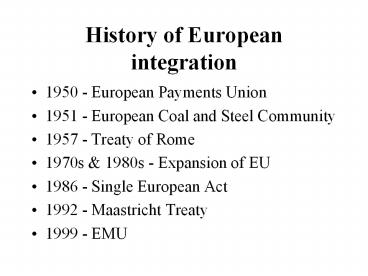History of European integration - PowerPoint PPT Presentation
1 / 37
Title:
History of European integration
Description:
Introduction of euro notes & coins. EMU. Profound change in international monetary relations ... Challenge from high-denomination euro notes? A model for the future? ... – PowerPoint PPT presentation
Number of Views:32
Avg rating:3.0/5.0
Title: History of European integration
1
History of European integration
- 1950 - European Payments Union
- 1951 - European Coal and Steel Community
- 1957 - Treaty of Rome
- 1970s 1980s - Expansion of EU
- 1986 - Single European Act
- 1992 - Maastricht Treaty
- 1999 - EMU
2
Two dimensions
- Political
- -Council of Ministers as decision making body
- -European law
- -European Parliament (directly elected since
1979)
- Economic
- -Eliminate internal customs duties and quotas
- -Common external trade policy
- -Creation of single market
3
GDP growth 1990-2000
4
Unemployment 1990-2000
5
No New Economy in EuropeProductivity growth
1990-2000
6
EMU What happened?
- January 1, 1999 (Stage IIIA)
- Formal launch of euro
- ECB takes over monetary policy
- January 1, 2002 (Stage IIIB)
- Introduction of euro notes coins
7
EMU
- Profound change in international monetary
relations - Between the countries of Europe
- Between Europe and the rest of the world
- Model for what we will see in the 21st century?
8
Why does it matter for Europe?
- Fundamental change in monetary policy
- ECB independent
- Mandate for price stability
- Significance of currency as symbol of sovereignty
- Move towards super state
9
The euro
10
The 1 coin
11
The 5 note (front)
12
The 5 note (rear)
13
The 10 note (front)
14
The 10 note (rear)
15
The 50 note (front)
16
The 50 note (rear)
17
The 100 note (front)
18
The 100 note (rear)
19
The 200 note (front)
20
The 200 note (rear)
21
The 500 note (front)
22
Institutions
Council of Ministers
European Commission
European Parliament
European Central Bank
23
Policy making institutions
6 Executive Board Members of the ECB
Governing Council of the ECB
12 National Central Bank Governors
Monetary policy for euro area
24
Strategy accountability
- Twin pillars of ECB monetary policy strategy
- Broad based assessment of outlook for price
stability - Reference value for money growth
- Quantitative definition of price stability
- 2 inflation or less
25
Three facets of EMU
- Creation of European super state
- Deepening and strengthening the single market
- Monetary stability through new institutions
26
Why does it matter for the US?
- Europe is our most important trading partner
- Europe is the most important source of investment
in the US - The euro as a competitor with the dollar
27
Destination of US exports
28
Source of US imports
29
Source of US FDI
30
Destination of US FDI
31
The euro as a competitor with the dollar
- US dollar dominant in international transactions
- size and global reach of US
- stability of purchasing power
- Benefit to US seigniorage revenue
- Challenge from high-denomination euro notes?
32
A model for the future?
- National central banks an expensive luxury?
- The debate over dollarization
- Monetary union as an alternative?
33
Dollar-euro exchange rate
per ?
Launch of EMU
per ECU prior to 1999
34
EU expansion
Other EU
Candidate countries
Euro area
Candidate countries not shown Malta and Cyprus
35
The demographic timebomb
36
Will the euro displace the dollar?
- Dollar currently the primary international
currency - Euro has potential to match and even displace the
dollar - But...
37
Will the euro displace the dollar?
- Difficult to dislodge established currency
- Thirty years for dollar to displace sterling
- Would it matter?































